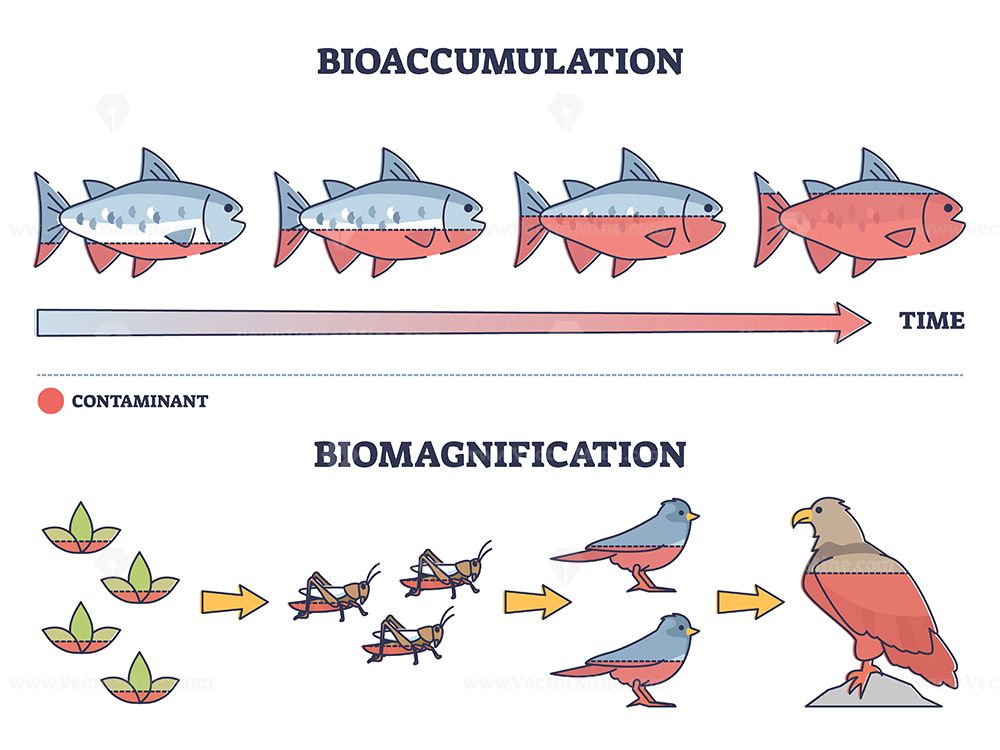Bioaccumulation and biomagnification are two interconnected yet distinct processes that describe the fate of pollutants within ecosystems. These concepts are crucial in understanding the dynamics of environmental pollution, particularly in the context of toxic substances that can have detrimental effects on wildlife and human health. To delve into the nuances of these processes, it's essential to first establish a foundational understanding of each.
Understanding Bioaccumulation

Bioaccumulation refers to the process by which substances, such as pesticides, heavy metals, and other chemicals, gradually accumulate in the tissues of living organisms over time. This accumulation occurs when the rate of intake of a substance exceeds the rate of its elimination. Bioaccumulation can happen through various exposure routes, including ingestion, inhalation, and dermal absorption, depending on the nature of the substance and the organism in question. The extent of bioaccumulation can vary widely among different species and is influenced by factors such as the chemical properties of the substance, the organism’s metabolism, and its position within the food chain.
Factors Influencing Bioaccumulation
Several factors influence the degree of bioaccumulation in an organism. The lipophilicity (fat solubility) of a chemical is a significant factor, as substances that are more lipophilic tend to bioaccumulate more readily in fatty tissues. The persistence of the chemical in the environment, its concentration, and the duration of exposure are also critical. Additionally, the size and age of the organism can affect bioaccumulation rates, with larger and older organisms generally accumulating higher concentrations of substances over their longer lifetimes.
| Chemical Property | Influence on Bioaccumulation |
|---|---|
| Lipophilicity | Higher lipophilicity leads to greater bioaccumulation |
| Persistence | More persistent chemicals bioaccumulate to a greater extent |
| Concentration and Exposure Duration | Higher concentrations and longer exposure durations increase bioaccumulation |

Exploring Biomagnification

Biomagnification, on the other hand, describes the process by which the concentration of a substance increases with each trophic level in a food chain. This phenomenon occurs because predators consume many prey organisms, each of which has accumulated substances, leading to a cumulative effect where the concentration of the substance is magnified at higher trophic levels. Biomagnification is a critical concept in understanding why top predators, such as eagles, sharks, and polar bears, often have the highest levels of pollutants in their bodies.
Examples of Biomagnification
A classic example of biomagnification is the accumulation of DDT (dichlorodiphenyltrichloroethane) in aquatic ecosystems. DDT is a pesticide that was widely used until its ban in many countries due to its harmful effects on the environment. In aquatic food chains, DDT would bioaccumulate in phytoplankton and zooplankton, which are then consumed by small fish. These small fish are eaten by larger fish, and the process continues up the food chain. Each step results in a higher concentration of DDT, leading to significant biomagnification by the time it reaches top predators like fish-eating birds or marine mammals.
Key Points
- Bioaccumulation is the gradual accumulation of substances in an organism over time.
- Biomagnification refers to the increase in concentration of a substance at each trophic level in a food chain.
- Both processes are critical in understanding the environmental fate and effects of pollutants.
- Lipophilicity, persistence, concentration, and exposure duration are key factors influencing bioaccumulation.
- Biomagnification leads to higher concentrations of pollutants in top predators, posing significant risks to their health and, by extension, the health of ecosystems.
The distinction between bioaccumulation and biomagnification, while subtle, is essential for a comprehensive understanding of how pollutants interact with and affect ecosystems. Both concepts underscore the importance of considering the broader ecological context when assessing the environmental impact of chemical substances. By recognizing how substances accumulate in organisms and are magnified through food chains, we can better manage risks, develop more effective regulations, and work towards mitigating the harmful effects of pollution on the environment and human health.
Environmental and Health Implications
The implications of bioaccumulation and biomagnification are far-reaching, affecting not only the health of ecosystems but also human health. Many pollutants that bioaccumulate and biomagnify are toxic and can cause a range of health problems, from neurological damage and reproductive issues to increased risk of cancer. For humans, exposure to these pollutants can occur through the consumption of contaminated food, particularly seafood and other wildlife that may have high levels of accumulated toxins.
Strategies for Mitigation
To mitigate the effects of bioaccumulation and biomagnification, it’s essential to adopt a multi-faceted approach. This includes reducing the release of pollutants into the environment through stricter regulations and more effective waste management practices. Additionally, promoting sustainable agricultural practices, reducing the use of persistent chemicals, and encouraging the development of safer alternatives can help minimize the accumulation of harmful substances in the environment. Public awareness and education are also crucial, as informed consumers can make choices that support environmentally friendly practices and reduce their exposure to pollutants.
What is the main difference between bioaccumulation and biomagnification?
+Bioaccumulation refers to the accumulation of substances in an individual organism over time, whereas biomagnification describes the increase in concentration of a substance as it moves up the food chain.
Why are top predators more susceptible to the effects of biomagnification?
+Top predators are more susceptible because they consume a large quantity of prey that have already accumulated substances, leading to a higher concentration of these substances in their bodies.
How can individuals reduce their exposure to pollutants that biomagnify?
+Individuals can reduce their exposure by making informed dietary choices, such as limiting the consumption of fish and seafood known to have high levels of pollutants, and supporting sustainable and environmentally responsible practices.
In conclusion, the processes of bioaccumulation and biomagnification are intricate components of the broader discourse on environmental pollution and its impact on ecosystems and human health. Understanding these concepts is essential for developing effective strategies to mitigate the harmful effects of pollutants and for promoting a healthier, more sustainable relationship between human activities and the natural environment.



